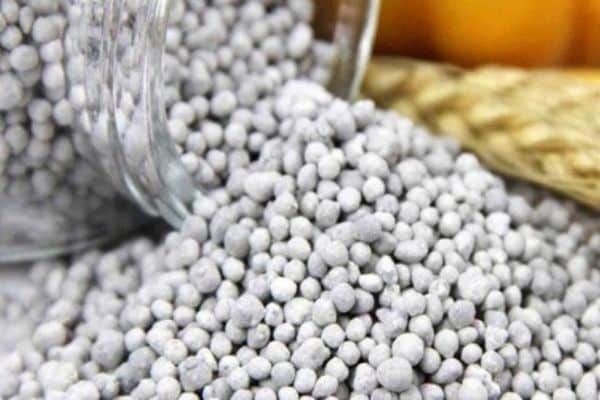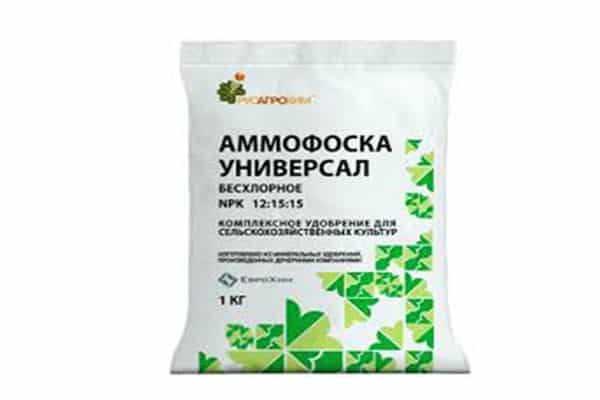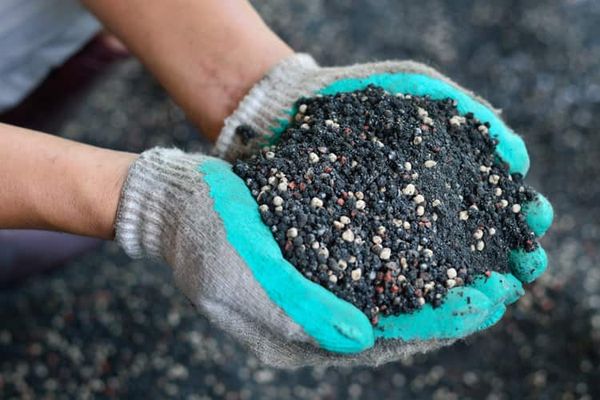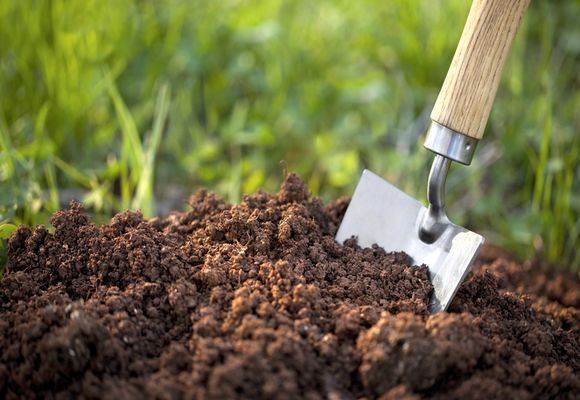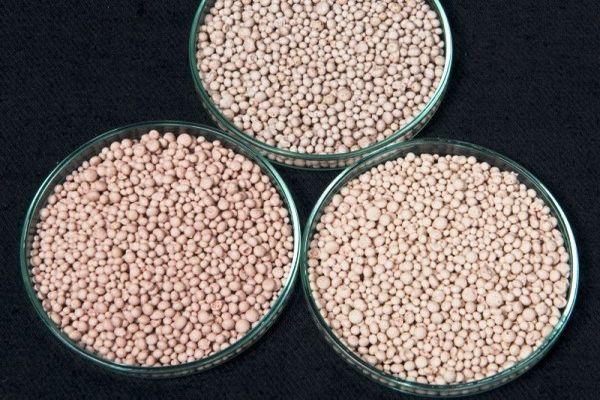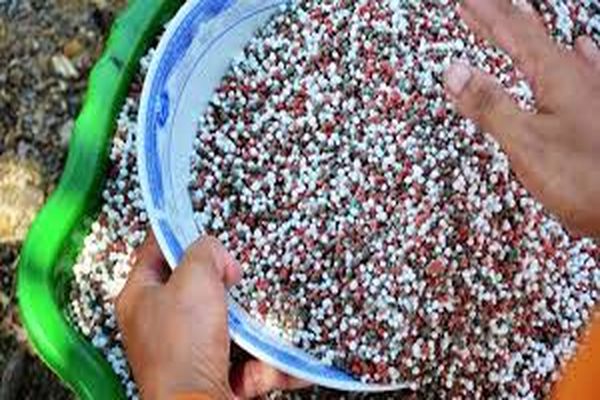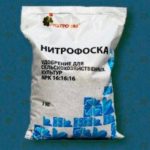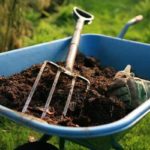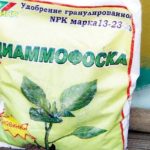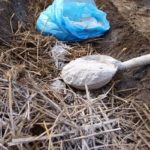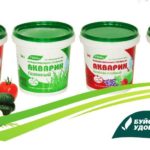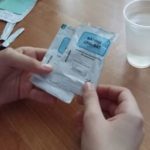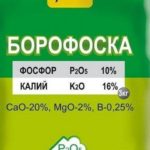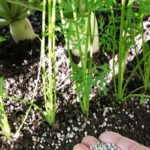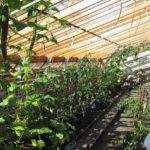When choosing fertilizers for a garden, a summer resident evaluates the composition of the drug, its effect on all types of crops and the price. Ammofoska is an affordable product that can be used on any soil (fertilizing, direct application to the soil during plowing).
- Composition and purpose of Ammofoski
- Advantages and disadvantages
- Behavior in soil
- Ammonium ion
- Sulfate ion
- Phosphate-ones
- Potassium ion
- Application on various types of soils
- Soddy-podzolic soils
- Ordinary chernozems, carbonate, southern
- Chestnut soils, gray soils
- Impact on plants
- Flowers
- Potato
- Peppers
- Tomatoes
- Pear
- Seedling
- Ornamental plants
- Legumes, sugar beets
- Wheat
- Sunflower, soybean, rapeseed
- Consumption rates
- How to use?
- How to store?
- Security measures
- Compatibility with other fertilizers
Composition and purpose of Ammofoski
Complex fertilizer (fat) has the form of granules (6 mm), they contain four chemical elements:
- The first and main one is phosphorus (ammonium phosphate, potassium phosphate), it is 15%, it participates in the process of nucleotide synthesis, supplies energy to metabolic processes occurring in plants.
- The second most important is nitrogen (ammonium sulfate) in percentage terms it is less (12%). It is necessary to increase productivity.
- Potassium sulfate (15%) stimulates the immune system and affects productivity.
- The granules contain sulfur (14%), which facilitates the absorption of nitrogen by plants.
Ammofoska is used in all regions of the Russian Federation, but there are climatic zones where the fat brings maximum effect. An urgent need for phosphorus is felt by plants grown in regions where drought is common. Farmers and amateur vegetable growers use this drug as a means of resuscitation for obvious signs of phosphorus deficiency in crops of any type and to restore soil fertility.
Advantages and disadvantages
Easily soluble phosphates are the main component of Ammofoska; they are responsible for the beneficial properties of the fertilizer:
- stimulate the formation of a developed root system;
- improve the taste of fruits;
- improve stress resistance of plants;
- increase productivity;
- the storage period is extended.
The absence of compounds containing chlorine and sodium is a clear plus. They are aggressive and a number of crops react poorly to them. Plus - the possibility of using fertilizer in a greenhouse.
Help: Universal ammophoska is applied to the soil in early spring; it is effective at sub-zero temperatures.
There are disadvantages, you need to know them when purchasing fertilizer:
- unsuitable for autumn fertilizing - stimulates the rapid growth of weeds;
- quickly loses its beneficial properties in unsealed packaging; after opening the package, the granules must be poured into a container with a tight lid.
Behavior in soil
Ammofoska is characterized by a long-lasting action. After adding granules to the soil, they gradually dissolve, which provides plants with nutrients for a long time. In the soil, fertilizer is converted into ions.
Ammonium ion
Formula NH4+, upon absorption of NH4+ with soil colloids, ammonium salts are formed. Plants spend less energy absorbing ammonium nitrogen than nitrate nitrogen. Ammonium is involved in the formation of amino acids, which are necessary for the synthesis of chlorophyll and the formation of proteins. Plants that prefer acidic soils absorb NH4+ better.
Sulfate ion
Most of the fat is made up of sulfate ions. These nitrogen compounds are less washed out of the fertile soil layers.
Phosphate-ones
These phosphorus compounds are easily dissolved, they are gradually converted into chemical compounds typical of a given type of soil, and are well absorbed by plants.
Potassium ion
A chemical compound is a participant in absorption processes (exchangeable, non-exchangeable).
Application on various types of soils
Can be used on any type of soil. The best results are achieved when applied to sandy, clay and peat soils.
Important! Ammophos is an excellent fertilizer for crops grown in protected soil conditions.
Soddy-podzolic soils
Ammophoska is applied during planting as the main fertilizer. A positive result is observed when applied to certain crops:
- potato;
- grain crops;
- sugar beets;
- linen.
Ordinary chernozems, carbonate, southern
This type of soil is typical for steppe zones.Ammophos is applied to chernozems of any type without the use of other types of fertilizers containing nitrogen. This applies to applying fertilizer to the soil and using it as a top dressing (root, foliar).
Chestnut soils, gray soils
The effect of using this fat is obtained on irrigated lands. Granules are applied in dry form, or combined with irrigation - the fertigation method.
Impact on plants
The use of multi-component fertilizer is recommended for crops of any type. A universal fertilizer makes plants resistant to infections, increases their productivity, and improves pollination.
Flowers
All types of flowers are fed with Ammophoska in the spring. The granules are not scattered over the surface, but are buried into the soil during loosening to a depth of 2 to 5 cm.
Potato
When planting potatoes, granules are added to the planting hole (1 tbsp) in accordance with the rate specified in the instructions. Before placing the tuber, the fertilizer is lightly mixed with the soil. Ammofoska perfectly replaces organic matter (humus) and greatly facilitates the work of summer residents. One hundred square meters of potato field requires 2.5 kg of fertilizer.
Peppers
The fertilizer is added to the soil when preparing the bed for planting, and adult plants are fed with a solution prepared according to the instructions. For a 10-liter bucket take 10 tbsp. l. granules
Tomatoes
Tomatoes can be fed with Ammophoska in several ways:
- at the time of transplanting seedlings into the ground;
- at the beginning of flowering;
- 2 weeks after the formation of the first ovaries.
Pear
Fertilizer should be applied to pear trees in the spring. Throughout the season, the granules, dissolving in the soil, will feed the root system with the nutrients the fruit tree needs: at the beginning of the season - nitrogen, and during the fruiting period - potassium and phosphorus.Thanks to Ammofoska, the ripening process of fruits is accelerated and their taste improves.
Seedling
When growing seedlings of vegetable and flower crops, it is recommended to purchase Ammofoska universal. To prepare a liquid solution, dissolve 3 to 5 g of fertilizer in 1 liter of water. When transplanting seedlings into the ground, granules are poured into the hole (1 tsp), mixing them with the soil.
Ornamental plants
Lawn grass and decorative foliage plants should be fed with Ammophoska in the spring. Shrubs gain green mass faster. Granules must be added to the soil; if you scatter them over the surface, most of the nitrogen will evaporate. The maximum planting depth is 5 cm. A well-watered lawn is fertilized by simply scattering granules over its surface (25 g/m²).
Legumes, sugar beets
When planting beets, granules are applied into the planting furrow; the application rate is 10 g/m. Summer feeding increases the size of root crops and their sugar content.
Wheat
When pre-sowing Ammophoska is added to the soil, the percentage of wheat gluten increases. When intensively growing grain crops, fertilizing with multicomponent fertilizer can be carried out in the summer during the active growing season.
Sunflower, soybean, rapeseed
These crops, when fertilized with Ammophoska, increase productivity, and the percentage of oil content in the harvest increases. Both fertilizing is used during the period of active growth, and fertilizer is applied during plowing.
Consumption rates
You can find out the consumption rates from the table given on the packaging.
| Culture | Norm (g per sq. m) |
| vegetables | 25–30 |
| berries | 15–30 |
| flowers and ornamental plants | 15–25 |
| fruit trees | 50–100 |
How to use?
The instructions for use printed on the packaging provide precise recommendations for the use of the drug.There are application rates for each crop. When preparing the soil for planting in the spring, add 25 g/m2 to cultivated soil.², when plowing virgin soil, add 35 g/m², the norm for protected soil is 40 g/m².
How to store?
After opening the package, the fertilizer should be used immediately. If after feeding there are unused granules left in the bag, they should be poured into a container with an airtight lid, which should be stored in a dark room. When storing fertilizer in an open bag, nitrogen evaporates and the drug loses some of its beneficial properties.
Security measures
When using a chemical, it is necessary to observe basic safety measures and use simple personal protective equipment:
- respirator when working with large volumes of fertilizer;
- work clothes made of thick fabric;
- rubber gloves.
After finishing work on feeding plants, you must use soap to wash your hands and face. If a chemical comes into contact with the mucous membrane of the eye, you should immediately rinse your eyes with running water and then see a specialist (ophthalmologist).
Compatibility with other fertilizers
When restoring the fertility of depleted soil, Ammofoska is used together with potassium and nitrogen fertilizers. Do not mix fat with alkaline fertilizers:
- ash;
- calcium nitrate;
- sodium nitrate.
When they are combined, most of the nitrogen is lost, and phosphorus compounds are not absorbed.
Ammofoska is an affordable fertilizer, easy to use, and gives a good increase in yield.

